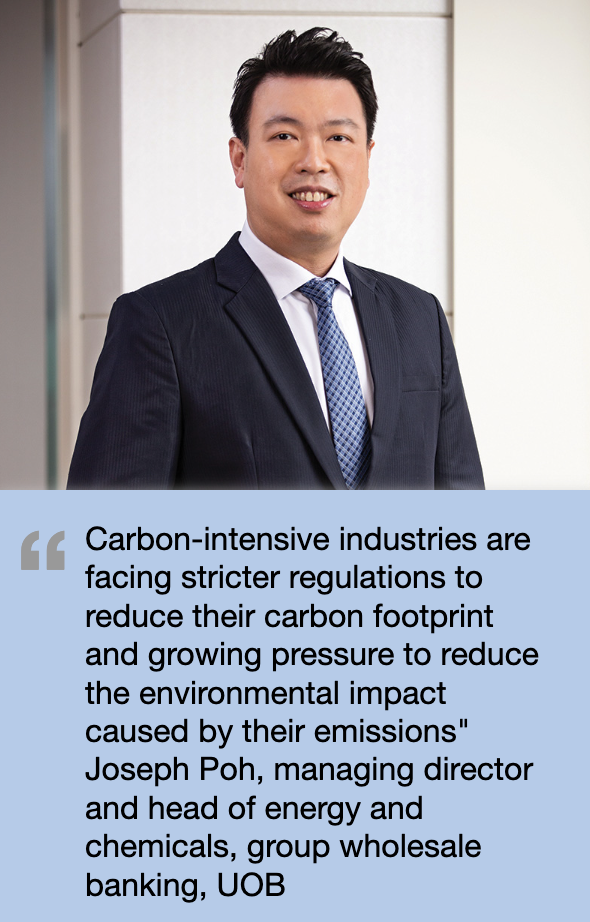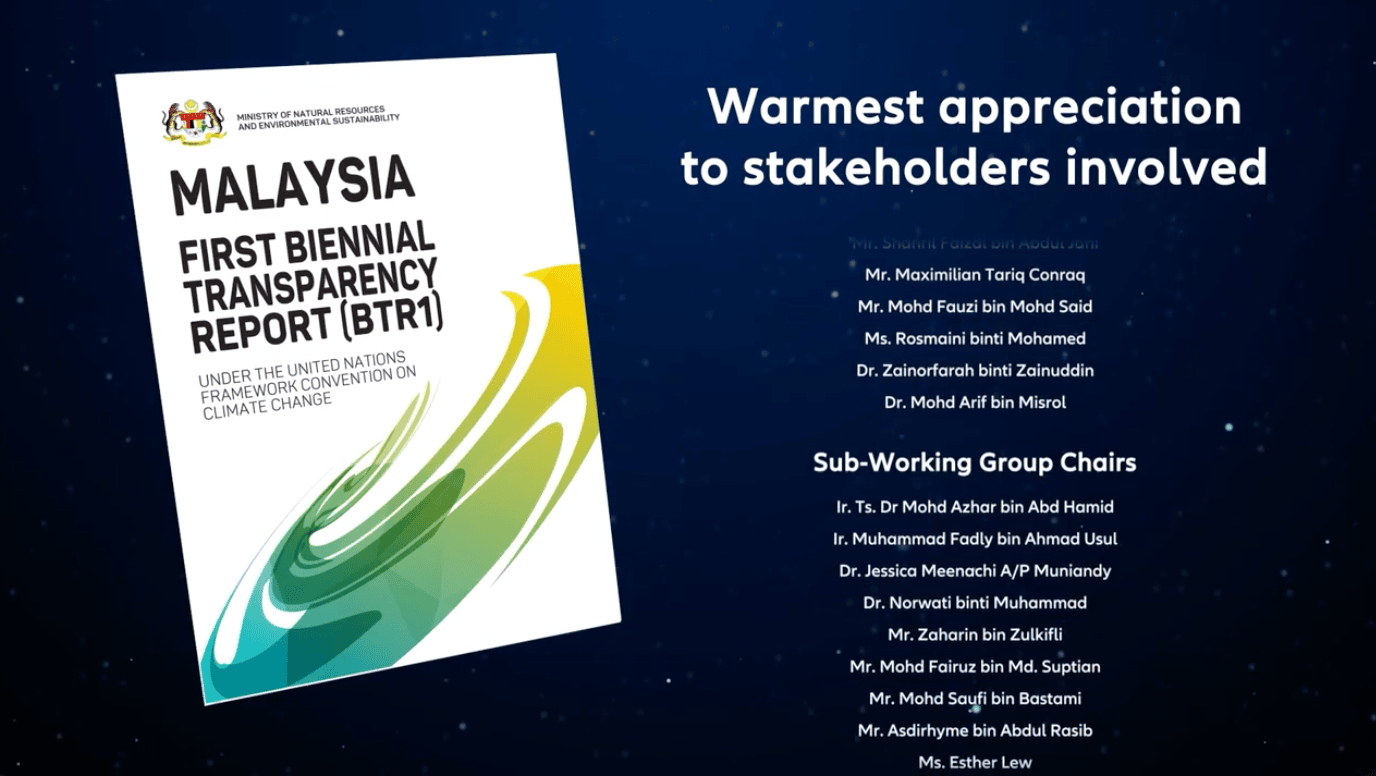
Four key industries — oil, gas and chemicals; metals and mining; fossil fuel power generation; and transport and logistics — are heavily reliant on fossil fuels and account for more than 50% of greenhouse gas (GHG) globally.
In Malaysia, carbon dioxide (CO2) emissions are dominated by the burning of fossil fuels for energy production such as in power plants or transport, and industrial production of materials such as cement.
These sectors are often referred to as carbon-intensive, high-emitting and hard-to-abate sectors. Malaysia has set a target to reach net zero emissions by 2050. The short-term goal is to reduce GHG emissions by 45% by 2025. The country emitted 256 million tonnes of carbon dioxide equivalent (CO2e) in 2021.
Joseph Poh, managing director and head of energy and chemicals, group wholesale banking, UOB, says, “These carbon-intensive industries are facing stricter regulations to reduce their carbon footprint and growing pressure to reduce the environmental impact caused by their emissions.”

Energy efficiency as first step in de-carbonisation
Improving operational efficiency, which results in the reduction of energy use, is usually one of the first steps that companies can take to effectively and efficiently reduce their overall GHG emissions. It requires minimal capital investment as it does not require an overhaul of existing production technologies or business models.
An industrial plant typically spends 30% to 50% of its operating budget on energy, hence it is critical to focus on industrial energy efficiency to minimise energy loss and energy spend. Companies can improve operational efficiency by using some common solutions such as installing waste heat recovery, co-generation or combined heat and power systems.
The International Energy Agency (IEA) emphasises that “stronger energy efficiency is the first best policy to bring down energy bills”. Therefore, energy efficiency benefits companies in such carbon-intensive, high-emitting and hard-to-abate sectors in terms of long-term energy cost savings and reduction in operating costs.
Dialog Group, the largest oil and gas terminal facility operator in Malaysia, consumed around 43.9 million kWh of energy in 2022. The company has incorporated energy efficiency as a priority in its Climate Change Strategy to reduce Scope 1 and 2 emissions.

Emission reduction solutions
In carbon-intensive industries such as crude oil refining and petrochemical production, gas flaring is a process used to burn off associated gases such as methane, liquified petroleum gas (LPG) and sulfur dioxide generated during industrial processes. Burning of these associated gases is a key source of GHG emissions.
But refineries installed with flare gas recovery systems can reduce such GHG emissions by up to 80%. A flare gas recovery system recovers and repurposes associated flare gases and emissions that would normally be burned during the flaring process, resulting in a reduction in fuel costs.
It is crucial to operate the refineries and petrochemical facilities safely by capturing such flare gases from the flare knock-out vessels and compressing them using liquid ring compressors. The recovered gases can then be reused within the facility’s fuel gas system as a refinery feedstock or for re-injection.
Yinson Group, an energy infrastructure and technology company listed on Bursa Malaysia, has committed to ambitious climate goals of achieving carbon neutrality by 2030 and net zero by 2050. Under the group’s offshore production division, adoption of technologies such as vapour recovery units and enclosed flare systems are expected to reduce the group’s carbon intensity by 30%.
Digitalisation to enhance operational efficiency
Digitalisation can help companies in the manufacturing and industrial sectors become smarter and more sustainable through better capture and use of energy consumption data, leading to more efficient energy use and tighter resource management. Digitalisation enables real-time collection of data to identify problems that cause wastage or unnecessary energy loss.
Historically, production plants have reviewed monthly energy usage data over time to monitor energy loss. Internet of Things (IoT) applications and energy management information systems (EMIS) are able to provide up-to-the-minute information about a site’s energy consumption to better identify inefficiencies and irregularities, providing real-time data and analytics for decision making.
Based on the UOB Business Outlook Study 2023 (SME and Large Enterprises), nearly six in 10 businesses in Malaysia have seen success with digitalisation efforts. Digitalisation plays a key role in helping businesses improve productivity and save on operational costs to mitigate the impact of inflation.
Government incentives to drive operational efficiency
The regulators are imposing stricter regulations on carbon-intensive, high-emitting and hard-to-abate sectors, as any reduction of GHG emissions by these companies will bring about a significant improvement to GHG emission at the national level.
The government has rolled out further financial incentives to motivate these companies to adopt environment-friendly practices with purchases of green technology assets. Malaysia Green Technology and Climate Change Corporation (MGTC) administers the Green Investment Tax Allowance (GITA) to support companies that are acquiring green technology assets or the Green Income Tax Exemption (GITE) for qualifying green technology service provider companies.
Companies purchasing equipment to promote or improve energy efficiency, co-generation systems and energy management systems are on the list of qualifying assets that are eligible for GITA asset incentive for any purchases made before Dec 31, 2025. GITA supports companies with 100% of qualifying capital expenditure incurred on eligible green technology assets.
Further, small- and medium-sized enterprises (SMEs) that are involved in providing technology solutions related to energy efficiency are also eligible for Bank Negara Malaysia’s High Tech and Green Facility, which provides financing for the companies’ capital expenditure and working capital.
Decarbonising carbon-intensive sectors with operational efficiency
Apart from government incentives, financing support from banks like UOB are also available for companies in the carbon-intensive, high-emitting and hard-to-abate sectors to support their decarbonisation efforts. However, such an effort is not a one-size-fits-all solution. A sectoral approach is key because it recognises that each sector or industry has unique characteristics that require tailored strategies to decarbonise their operations.
More information on UOB’s industry perspective, please visit HERE
- Eco World International clarifies bumper dividend issue
- Home minister refutes allegations of Chinese nationals being granted Malaysian citizenship to become DAP voters
- Minimum wage of RM1,500 remains under progressive wage system, says Sivakumar
- India tightens rice exports in threat to global food prices
- All parties should abide by PM’s comment barring use of party logos for govt aid, says Loke

Source: The Edge




























